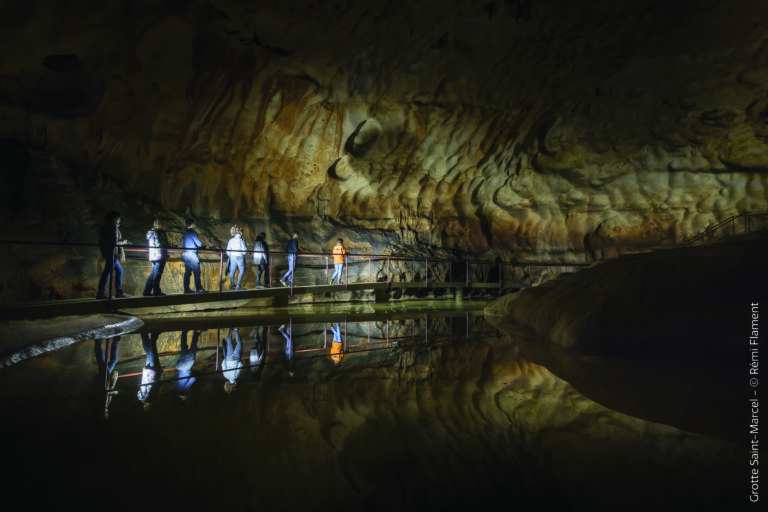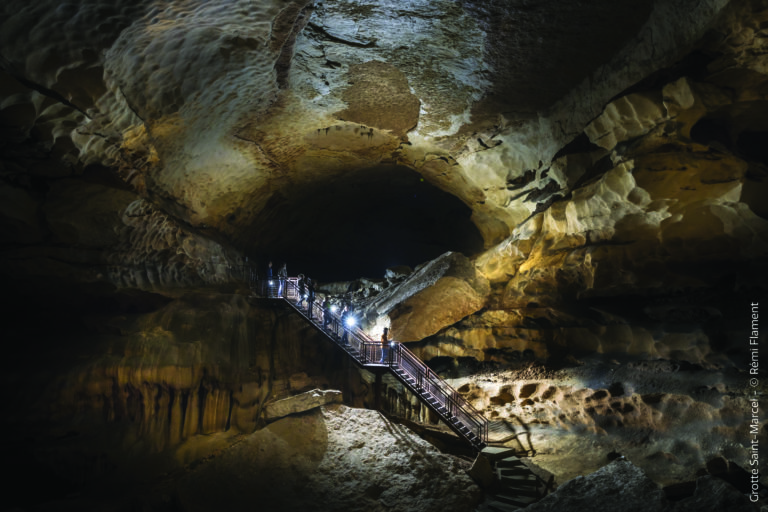Classification : Classified Site / National Nature Reserve
Management organization : Municipality of Saint Marcel d’Ardèche and Syndicate of Management of the Ardèche Gorges
Presentation :
The natural entrance, the main resurgence of the old underground river at the origin of the digging of the network, was discovered in 1836 below the current touristic site, 40 m above the Ardèche river. Today, the Saint-Marcel network is one of the largest underground networks in France with 60 km of galleries spread over three main levels.
Known for the scale of its development, the beauty and the volumes of its galleries, the Saint-Marcel network develops over 230 m in height with 2 main fossil upper levels and an active lower level extending to the current level of the Ardèche and in places up to 60 m below. Scientific studies in geology, archeology, hydrology and climatology carried out on the network contribute to the international reputation of the site.
Scientific or educational interests :
- Geology : a reference site
The study of the fossil levels of the Saint-Marcel network showed that its digging was carried out during two consecutive phases linked to variations in the level of the Mediterranean Sea following the Messinian salinity crisis. The re-watering of the Mediterranean basin around 5.3 million years ago caused a rise in the baseline and a deepening of the underground network “by ascensum” (Mocochain, 2006). The Saint-Marcel network is thus known in international scientific literature as a reference site, the morphology of its galleries and chimney shafts retaining the memory of this essential geological episode.
- Prehistoric archeology : from the Middle Paleolithic to the Chalcolithic
Archaeological excavations have brought to light the occupation of the network by prehistoric Man from the Middle Paleolithic. Thus, the area under the porch has made it possible to identify a reference site providing information on the
occupation of Neanderthals in Sud-Ardèche between 90,000 and 38,000 years BP (Gilles 1986, Moncel et al. 2004, Szmidt and al. 2010).
A Palaeolithic painting dated from the Solutrean (21,650 +/- 800 BP) was discovered in 1964 on the upper level, in the cave known as the “Lion’s head”, at the end of what seems to be an old resurgence of the network.
Finally, in the gallery of the natural entrance, a hundred meters from the entrance porch, a Neolithic site and a Chalcolithic site were excavated in the 1980s (Gilles 1988).
An overall reflection on the accessibility of the site during the different prehistoric periods as well as a prospecting campaign are currently being planned by the site management.
- Paleontology : a bear cave
In addition to the relatively frequent occasional finds of animal bones at various places in the network, an excavation recently uncovered a skull of cave bears associated with a flint cut at the end of the gallery of the natural entrance (Moncel and al. 2016, 2017). Following this discovery, careful prospecting carried out in this gallery as well as in other points of the deep network led to the identification of numerous polished, scratches and even some footprints of cave bears (Philippe, in preparation).
- Hydrology : an active network being explored
Recent hydrological research has revealed the existence of a particular ecosystem in the submerged galleries of the network resulting from the coexistence of two sources of water supply : karst waters from the supply basins of Bidon or SaintRemèze and the waters of the Ardèche. Saint-Marcel is connected to the water table forming the largest reserve of water in the Alès basin (Cailhol 2016).
- Climatology : reconstruction of the paleo environment between – 120,000 and – 12,000 years
The underground networks are also extraordinary archives for the knowledge of the paleo-climatic history of the planet. The analysis of stalagmite growth rings completes the information provided by the analysis of ice cores. Collaborative research between researchers from the University of Savoy and Melbourne is currently underway on samples taken from the site (Corrick et al., In preparation).
- Planetology : reference sources for the study of the formation of other terrestrial and extraterrestrial environments
In addition to the knowledge already well established in the field of patterns formed on soft substrates (wind dunes and wrinkles, water current wrinkles, snow dunes), the patterns that develop in an underground context, on solid rocky ground by dissolution (blows gouges) or precipitation (travertine dams or “gours”) provide new data. The study of the models aims at the development of a method of reconstitution of the characteristics of the flows and ultimately to support hypotheses on the formation of the various aspects of surfaces observed in other terrestrial or extraterrestrial environments (Mars, Pluto, ice satellites of Saturn and Jupiter, comets,…) (Bourgeois, in progress)
- Oenology and underground environment : Wine aging experiments.
A wine aging experiment in oak barrels has been carried out over the past 5 years in the upper level of the network accessible to visitors. This action leads to problems of conservation of the underground environment, in particular with the appearance of fungi feeding on ethanol vapors. A bacteriological study is underway on this subject (Pfendler, in preparation).
Due to this pollution, only bottles were lowered this year.
Thematic keywords : archeology, biology, climatology, ecology, sedimentary geology, geomorphology, hydrology, impact on tourist numbers, karstology, meteorology, wine tourism, paleoclimatology, paleontology, prehistory
Keywords typology of sites : natural instrumented cave (CO2, radon), managed cave, karstology, wine tourism, paleoclimatology, canyon – gorge – karren, panorama reading landscapes, archaeological site, submerged network, mediation space, botanical trail
Access modalities:
Various access methods depending on the study projects : Direction of the tourist site of the Grotte Saint-Marcel, Syndicate of Management of the Ardèche Gorges, Departmental Committee of Speleology.
Possible support:
To see directly with the three entities mentioned according to the type of project (access to the developed or undeveloped network, thematic of the study).
The undeveloped network for tourism is classified as a specific environment by the Sports Code (Section R212-7). Also, supervision groups outside the tourist circuits of fitted out cavities requires specific skills, certified by a professional diploma issued by the State or federal issued by the French Speleology Federation.



